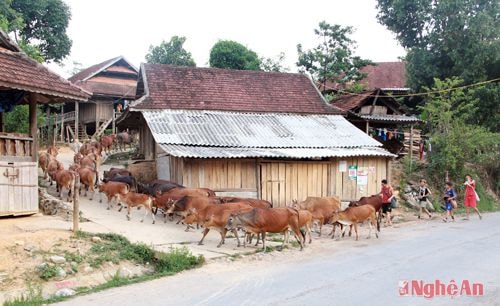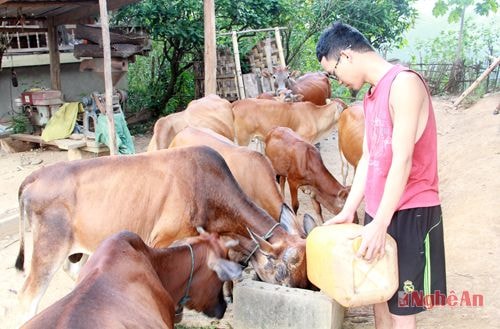The sound of bells on the mountainside
(Baonghean) - Perhaps I should start this article with my impressions of the bamboo fences of the people in the highlands of Nghe An. I really don't know why, but every time I set foot in the villages of Tuong Duong, Ky Son or Que Phong districts, I always feel something running through my fingers when I touch the fence posts tied to the area and strung across the mountain slopes. Inside the fences are herds of buffalo and cows leisurely grazing. The mountain scenery has never been so peaceful...
On the way from Muong Xen town to Bac Ly commune, when we reached Keo Luc 3 village, Pha Danh commune (Ky Son), we were forced to stop to “give” way for the herd of buffaloes and cows. For more than 10 minutes, we just sat with our feet on the “iron horse” waiting for the herd of buffaloes and cows to pass. If we were in the plains, we would have been annoyed, and maybe our companion would have said a few harsh words. But in the mountainous areas, this is normal, it even reflects the life of ethnic minorities in the fullest and most peaceful way.
And on a beautiful morning halfway up the mountain, we decided to stop and find Keo Luc 3 village. Why is it called Keo Luc 3? Because in Pha Danh commune there are also Keo Luc 2 and Keo Luc 1. Normally, the administrative areas of typical mountain villages are often divided according to the area, geographical location and population characteristics. Keo Luc 3 village is located close to National Highway 7A, in the morning, the stilt houses are scattered in the sunlight like musical notes printed on a love song. We crossed the gently sloping concrete road to find the house of the Chief of Keo Luc 3 village. While looking around and asking for directions, suddenly a woman's voice asked: "Are you buying cows?" It was a woman sitting weaving brocade on the loft of the stilt house next to the road. She introduced herself as Kha Thi Man and said that the Chief of Kha Van Mun village was her husband. “If you want to buy cows, you have to wait. Mun has already brought salt into the forest for the cows. He left this morning” – Man smiled brightly next to the weaving loom.
 |
| Households in Keo Luc 3 village herd cows back to the village. Photo: Ho Phuong |
It was early afternoon when Village Chief Kha Van Mun turned back to the village. From afar, he could see Mun walking and saying hello on the phone. Kha Van Mun looked more sturdy than his 33 years of age. Lowering the cradle, putting the knife in a wooden bucket, he told the customer: “Someone asked to buy a cow. He hasn’t sold it yet because it’s still too young. Not big enough yet. It will be sold in a few months.” Through conversation, Kha Van Mun said that Keo Luc 3 village currently has 75 households with 314 people. The whole village has more than 1,000 hectares of natural land, including forest land and production land. Most of it is limestone mountains and forests that cannot be used for agricultural production. “The land is for growing corn, not much for growing rice. Up here, it is not like in the lowlands, where land is calculated by sao or mau. We only calculate the amount of seeds sown. Each year, per person, we get about 500 kg of rice. Last season, the whole family only got a few hundred kg” - Chief Mun shared, and he also said that if he did not do a side job, the village would be hungry all year round.
The secondary occupation of Keo Luc 3 village is raising cattle and weaving brocade. If weaving brocade is the work of women, raising cows is the job of men. Keo Luc 3 village currently has a herd of 235 cows, a herd of more than 200 pigs, and a flock of about 200 chickens. Asked specifically about the cows, Kha Van Mun said that in the past, the villagers did not realize the economic value, so they raised few and the care was very simple. The cows were left in the forest for a few months before being checked once. That is why there was a situation where cows and calves from this village were mixed with other villages. But now things have changed. In the village, groups of cows have been formed to develop the economy. Accordingly, each group has about 10 households, they contribute money, labor, dig holes, drive stakes, and build fences to surround the mountainous areas into concentrated grazing areas for buffaloes and cows.
In Keo Luc 3 village, there are nearly 10 such groups. Each group raises 20-30 buffaloes and cows together. Mr. Kha Van Bun's family has the most cows with 16, Mr. Kha May Mun has 10, even the village chief Kha Van Mun has 7 cows. On the hilly area with a stream flowing through, the cows are raised in an area of 13 hectares. "Every few days, I bring the cows back to the village so we can feed them salt, otherwise, the families in the group take turns bringing salt into the forest and checking. His cow is like me, it also needs salt to be healthy" - Kha Van Mun smiled, showing his black teeth.
Building fences to raise cattle is no longer a "bright spot" or "movement" in some villages in Western Nghe An, but is gradually becoming a habit in the livestock production activities of the people. The first benefit is being able to take care of, monitor, and closely manage the herd of cattle, without worrying about loss. When an epidemic occurs, it is detected in time and preventive measures are taken. Regarding this issue, many people said that their cattle are vaccinated periodically every year. Concentrated raising also helps households support mother cows and calves. The most important thing is the economic benefit. Each calf costs over 10 million VND, if it is an adult cow, it is from 15 to 30 million VND/head. "That forest, that food, the benefits right on our land, why don't we take advantage of it" - that is the confiding of Mr. Moong Pho Tom - Head of Huoi Cang 1 village, Bac Ly commune (Ky Son).
Pho Tam's family has 14 cows, 7 buffaloes, more than 20 pigs, not to mention a flock of dozens of black chickens. Because they see the benefits of their living area, in recent years many households in Bac Ly commune have expanded their scale and developed their herds of buffaloes and cows. And all of them have raised large herds of livestock in the form of fences. For a long time, many people still believe that in the Western Nghe An region, the Khmu ethnic people are not as hard-working as other ethnic minorities, but Mr. Cut Pho Duong - Chairman of the People's Committee of Bac Ly commune has affirmed the opposite. That: "If people are not hard-working, do not raise cows and buffaloes, what will they have to eat?" As if to prove what he said, Mr. Cut Pho Duong said that currently in Bac Ly there are nearly 1,400 cows, 652 buffaloes, 1,300 goats, nearly 2,000 pigs, and nearly 10,000 chickens and ducks. Mr. Duong also admitted: Bac Ly is a remote and extremely difficult commune, the poor still account for a high proportion of households, but on average each household has 4-5 buffaloes and cows. And raising large livestock is one of the long-term directions for developing the local economy. "If we just wait for the "winchman", we will starve to death by February or March" - Chairman of the People's Committee of Bac Ly commune waved his hand to the sky to explain.
 |
Because they cannot wait for "the sky to create the grass", many residents in Bac Ly have proactively discussed and agreed to fence off buffalo and cows. Mr. Cut Xuan Khanh in Huoi Cang 1 village said that every 5-6 households share a cattle raising area. When participating in the fence, depending on the number of buffalo and cows of each household, the contribution of steel fence rolls will be converted. Each 100m long steel roll costs 200,000 VND, families with many cows contribute 10-15 rolls, and those with few cows contribute 4-5 rolls. The fenced area for each group is about 2 hectares, according to the assignment, each household takes turns taking care of and monitoring for 1 week.
Like Huoi Cang 1, Pha Coong village is also raising cattle in a similar way. The village has 28 households with 132 people and every house has buffaloes and cows. Households in the village are grouped together by relatives and brothers. For example, the Cut family group has up to 10 families contributing money and labor to build a fence to create a livestock area with an area of over 3 hectares. There are always more than 60 buffaloes and cows of families such as Cut Pho Cho, Cut Pho Duong, Cut Van Cuong, Cut Pho Hoan... In addition, Pha Coong village also has cattle raising groups of the Chich family, Moong family... Thanks to raising buffaloes and cows, the poverty rate of Pha Coong has decreased from over 90% a few years ago to 50% now.
This is the visible effect in the area nearly 5km from the center of Bac Ly commune and nearly 40km from the center of Ky Son district. Mr. Cut Pho Duong - Chairman of the People's Committee of Bac Ly commune also said: The reason why the locality has developed livestock and expanded economic thinking is thanks to the road system invested by the State. Up to now, asphalt roads have reached the center of the commune and from the commune there are concrete roads to the villages. Thanks to that, the transportation of agricultural products in general and the sale of buffalo and cows in particular is also very convenient. "We have to build fences. We cannot wait for the state, hoping that he will "winch" forever" - the saying of the leader of the Khmu ethnic group left a lasting impression on me. It is true that everything started with rows of fences in the middle of the mountains and forests in the highlands. And the joy was even more intense when passing through Huoi Cang 1 village, a clear song suddenly echoed: "You are on the other side of the mountain/ Why don't you come back with me/ The sun wants to go to sleep/ My eyes are still waiting/ If you come back to me/ Remember the sound of the bells/ Wherever the cows are, I am there...".
Dao Tuan






